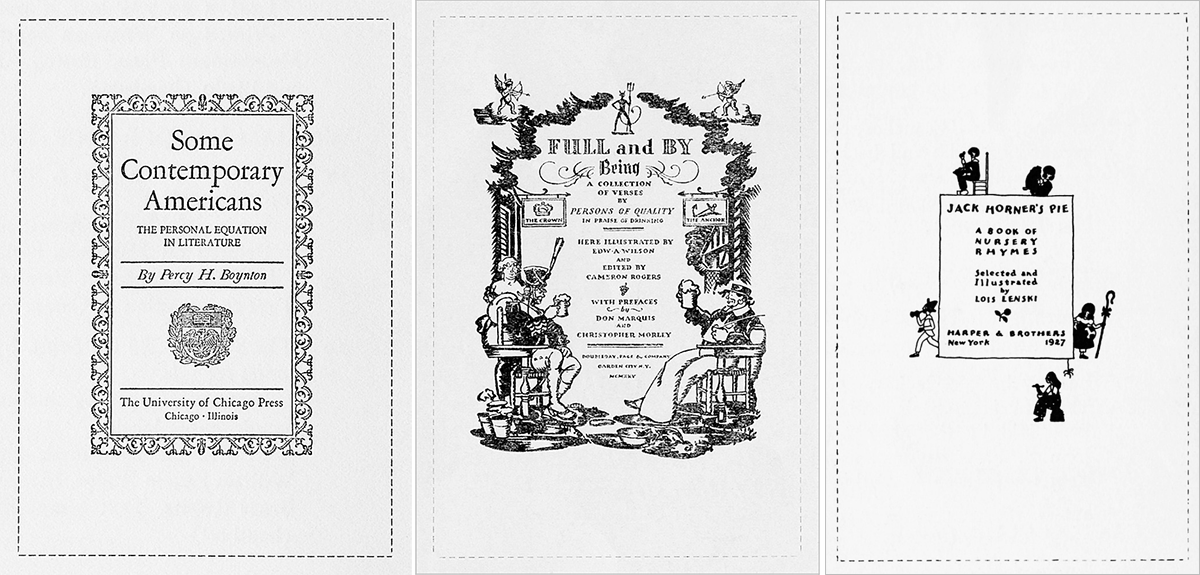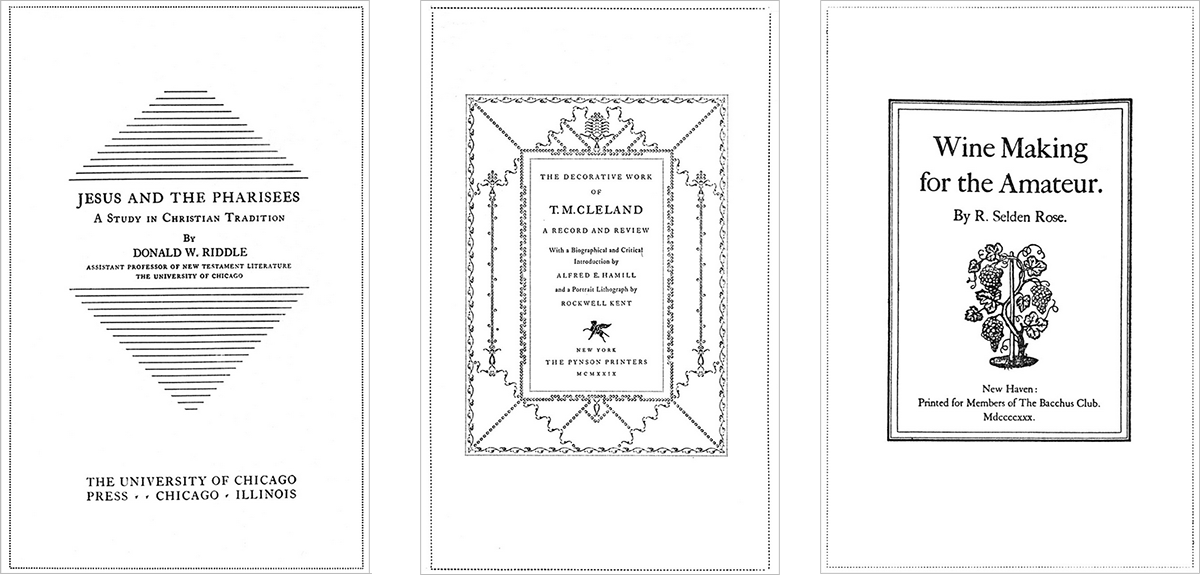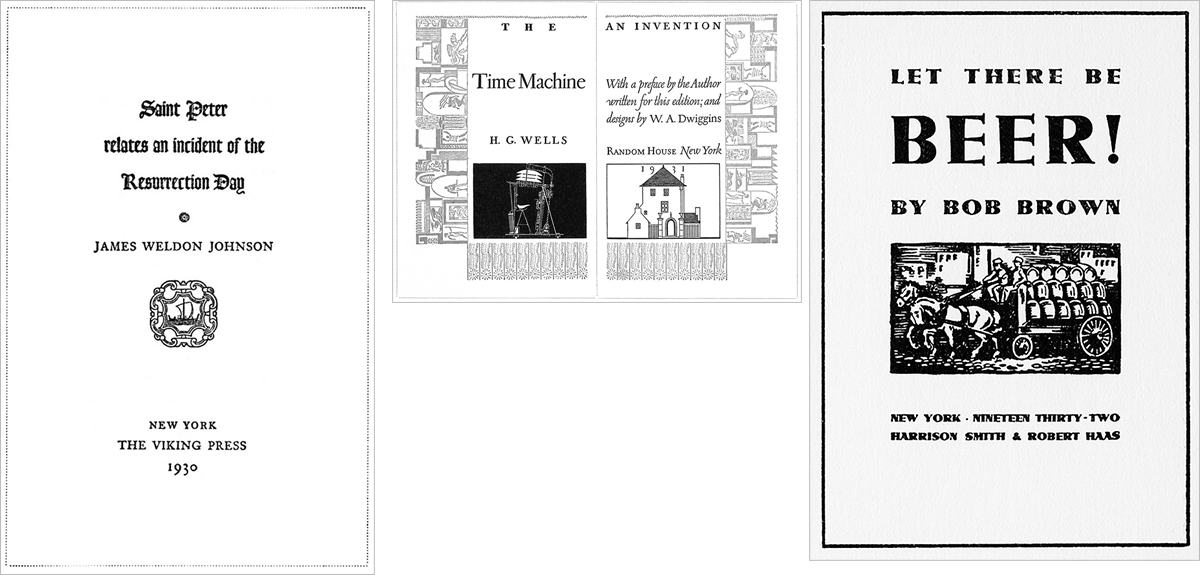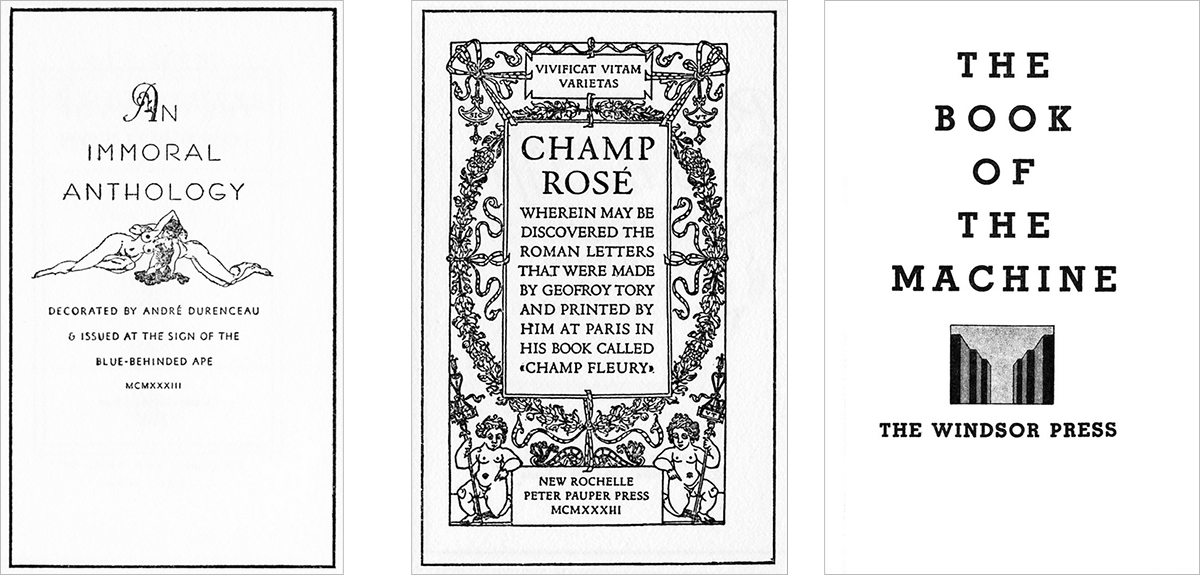
LEFT: Some Contemporary Americans: The Personal Equation in Literature, 1924. CENTER: Full and By: Being a Collection of Verses by Persons of Quality in Praise of Drinking, 1925. RIGHT: Jack Horner’s Pie: A Book of Nursery Rhymes, 1927.
With the historic 50 Books | 50 Covers competition entering its 94th year, AIGA and Design Observer join together to celebrate its legacy as the longest running book design competition in America.
AIGA archives director Heather Strelecki reflects on the first 15 years of the competition to find out what all the fuss was about—and to ring in another year, as then AIGA president H.W. Kent said in 1938, “uninterruptedly.” — The Editors

LEFT: Jesus and the Pharisees: A Study in Christian Tradition, 1928. CENTER: The Decorative Work of T.M. Cleland: A Record and Review, with a Bibliographical and Critical Introduction by Alfred E. Hamill, 1929. RIGHT: Wine Making for the Amateur, 1929.
In 1938, AIGA published Keepsake No. 59, Fifty Books of the Year, 1923–1938, a cumulative list of the books selected and shown by AIGA during the first 15 years of the beloved competition. The president of AIGA at the time, Henry Watson Kent, described the success of the competition this way:
“It is a matter for congratulation that the undertaking thus inaugurated by this thoughtful and farsighted group has been carried on uninterruptedly by their successors and with deserved growing influence.”
In the early years of AIGA’s book competition, which began in 1923, the jurors focused on the construction of the book and the printed page. Juror selections from this time period are represented by the title page, which often captured the essence of the book. As book production in the U.S. increased, AIGA’s suite of competitions expanded. In the 1960s, jurors began to evaluate the covers independent of the book—starting with Paperbacks U.S.A.—mostly because the text pages of the mass-market and egg-head varieties (elementary to high school books) were “generally uninspired and often shoddy, while the accompanying covers were gay and even brilliant.” Co-chaired by Bill Drenttel and Paul Davis, The 50 Books | 50 Covers of 1995 was the first competition to recognize excellence in both areas of design.

LEFT: Saint Peter Relates an Incident of the Resurrection Day, 1930. CENTER: The Time Machine: An Invention, 1931. RIGHT: Let There Be Beer!, 1932.
Today, there is nearly a century of book design available for research and inspiration in the AIGA Design Archives. As archivist at AIGA’s national office, my job is to help resurface the stories told by AIGA members, committees, and staff of long (and not so long) ago. They are preserved in exhibition catalogues, newsletters, and journals documenting the history of AIGA and the profession.
In 1938, Keepsake No. 59 said of the first competition juries, “Their judgments, as we look back, have been uniformly good—even their mistakes have been helpful—and their service has been a distinguished one.” To celebrate the launch of 50 Books | 50 Covers this year, I’m sharing a few of my favorite designs from its first chapter. We’ll leave the verdict of “uniformly good” up to you.

LEFT: An Immoral Anthology, 1933. CENTER: Champ Rosé, Wherein May Be Discovered the Roman Letters That Were Made by Geofroy Tory and Printed by Him at Paris in His Book Called “Champ Fleury”, 1933. RIGHT: The Book of the Machine, 1934.
Continuing the tradition, Gail Anderson, Michael Carabetta, and Jessica Helfand will review book and book covers from 2016. The most effective, well crafted, and beautifully executed work entered into the annual 50 Books | 50 Covers competition will be featured in the AIGA Design Archives.
Physical copies of selected books will be gifted to the Robert B. Haas Family Arts Library at Yale University and at the Rare Book and Manuscript Library at Columbia University’s Butler Library, where more than 5,000 books recognized for design excellence from nearly a century of AIGA competitions are housed.
Be a part of the legacy—the early deadline to apply this year is February 10.

LEFT: The Capture of Inspiration, 1935. CENTER: Puss in Boots, 1936. RIGHT: Letters from the Sandwich Islands, Written for the Sacramento Union, 1937.
RESOURCES
Source
Fifty Books of the Year, 1923–1938. (July 1938)
Location
AIGA Archives. AIGA: Keepsakes series: 1923–1948
AIGA Design Archives. Fifty Books of the Year (1925–1939)
Background
Henry Watson Kent was president of AIGA 1936–1938
In 1930, Kent received the AIGA Medal
He was Secretary of the Board of Trustees at the Metropolitan Museum of Arts. Prior to the Museum, he worked at the Slater Memorial Museum of the Norwich Free Academy and the Library of the Grolier Club in New York City. In his teens, he studied under the direction of Melvil Dewey at Columbia College, the first American school for library science instruction.
References
AIGA Medalists
AIGA presidents, 1914–present
“Book Publishers and Book Production.” News-Letter of the American Institute of Graphic Arts, no 22. March 1, 1928.
Feather, John. A History of British Publishing. Routledge, 1988. pp. 203.
The Metropolitan Museum of Art Bulletin. “Henry Watson Kent.” (JSTOR)
AIGA and Design Observer to join forces, setting a milestone in online design publishing
“Paperback Covers.” AIGA News Letter, April 1960. pp 3.
“Popular Vote on Fifty Books.” The News-Letter of The American Institute of Graphic Arts, no. 43. April 1937. pp 4–5.
